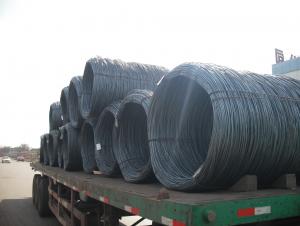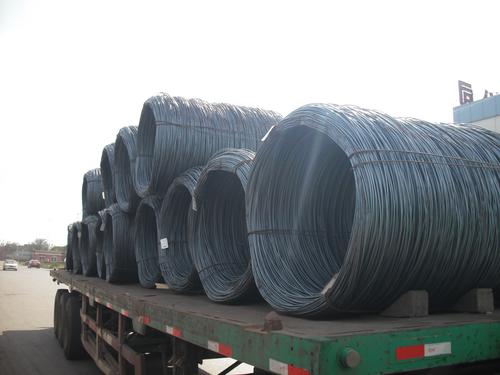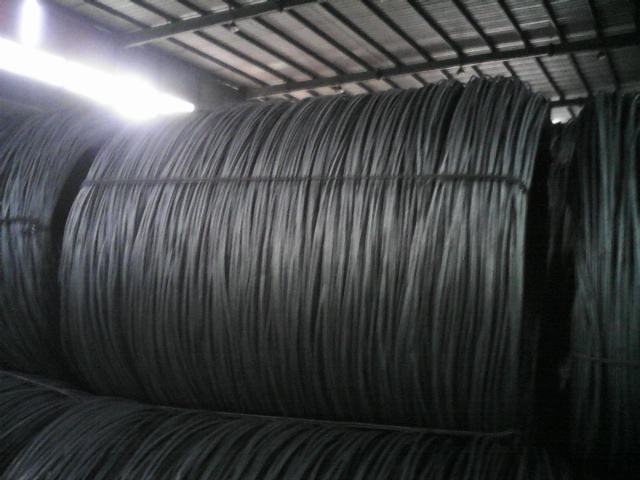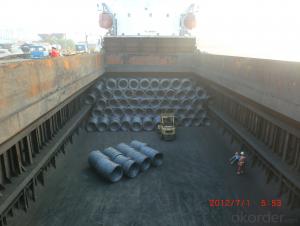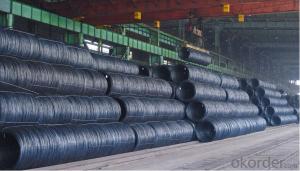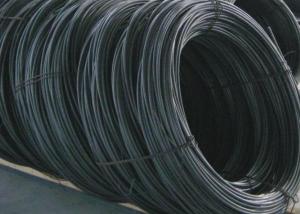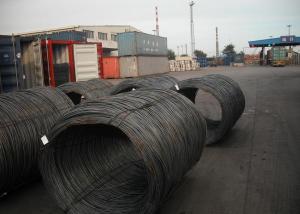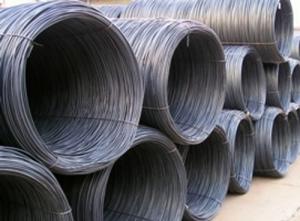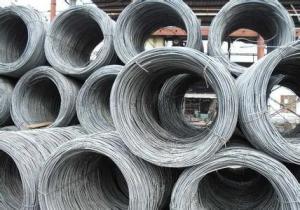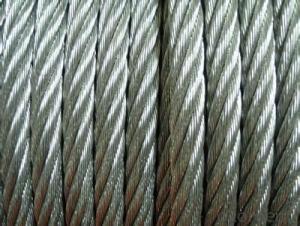High Quality Hot Rolled Carbon Steel Wire Rod
- Loading Port:
- China Main Port
- Payment Terms:
- TT or LC
- Min Order Qty:
- -
- Supply Capability:
- -
OKorder Service Pledge
OKorder Financial Service
You Might Also Like
Product Description:
OKorder is offering Wire Rod at great prices with worldwide shipping. Our supplier is a world-class manufacturer of steel, with our products utilized the world over. OKorder annually supplies products to European, North American and Asian markets. We provide quotations within 24 hours of receiving an inquiry and guarantee competitive prices.
Product Applications:
After hot-rolled the products shaped into coil and delivery as finished product, including round, square, rectangular, hexagonal and so on. Since most of the products are round, it is generally called wire rod. Carbon steel wire rod is widely used in construction and manufacturing. Carbon steel wire rod is mainly used for reinforcement of reinforced concrete and welded structure or reprocessed (roberts , nail, etc.) materials, especially used to produce wire drawing, welding electrode, nails, spring, electronic, precise machinery parts and so on.
.
Product Advantages:
OKorder's Wire Rod are durable, strong, and resist corrosion.
Main Product Features:
· Premium quality
· Prompt delivery & seaworthy packing (30 days after receiving deposit)
· Corrosion resistance
· Can be recycled and reused
· Mill test certification
· Professional Service
· Competitive pricing
Product Specifications:
Steel Grade: Q195/235, SAE1006-1018B Standard: ASTM, GB
Diameter: 5.5mm, 6.5mm, 7mm,8mm,9mm,10mm,12mm,14mm
Type: in coil, coil weight around 2MT Alloy or Not: Alloy
Surface: round, no twisted, light and smooth Chemical Composition: (Please kindly find our chemistry of our material based on Q195、Q235A and Q235B as below for your information)
Packaging & Delivery of Hot Rolled Wire Rod:
Packaging Detail: products are packed in coil, each coil weight around 2 MT, and then shipped by container or bulk vessel
Delivery Detail: within 45 days after received deposit or LC.
Label: to be specified by customer, generally, each bundle has 1-2 labels
Trade terms: FOB, CFR, CIF
FAQ:
Q1: Why buy Materials & Equipment from OKorder.com?
A1: All products offered byOKorder.com are carefully selected from China's most reliable manufacturing enterprises. Through its ISO certifications, OKorder.com adheres to the highest standards and a commitment to supply chain safety and customer satisfaction.
Q2: How do we guarantee the quality of our products?
A2: We have established an advanced quality management system which conducts strict quality tests at every step, from raw materials to the final product. At the same time, we provide extensive follow-up service assurances as required.
Q3: How soon can we receive the product after purchase?
A3: Within three days of placing an order, we will begin production. The specific shipping date is dependent upon international and government factors, but is typically 7 to 10 workdays.
Images:

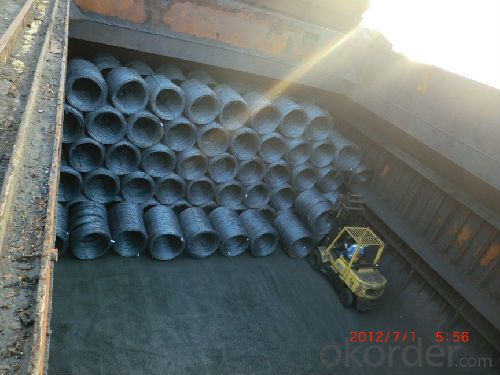
- Q: How is steel wire rod used in the manufacturing of fences and meshes?
- Steel wire rod is commonly used in the manufacturing of fences and meshes due to its strength and durability. It serves as the primary material for constructing the framework and support structure of fences and meshes. The wire rod is typically formed into various gauges and sizes to meet specific requirements, and it is then woven or welded to create the desired pattern or design. This ensures that the fences and meshes are strong enough to withstand external forces, provide security, and effectively restrict access or contain objects within a designated area.
- Q: What are the major innovations in steel wire rod production technology?
- Some of the major innovations in steel wire rod production technology include the introduction of continuous casting technology, which allows for more efficient production and better quality control. The development of advanced rolling mills that can produce wire rods with precise dimensions and surface quality has also been a significant innovation. Additionally, the integration of automation and digital technologies into the production process has led to increased productivity and improved product consistency.
- Q: What are the common heat treatment processes for steel wire rod?
- There are several common heat treatment processes for steel wire rods, each serving a specific purpose in improving the properties and characteristics of the material. These processes include annealing, quenching, tempering, and normalizing. 1. Annealing: This process involves heating the steel wire rod to a specific temperature and holding it there for a certain duration, followed by controlled cooling. Annealing helps to reduce the hardness and brittleness of the wire rod, improving its ductility and machinability. 2. Quenching: Quenching is a rapid cooling process that involves immersing the heated wire rod into a quenching medium, such as oil or water. This process rapidly hardens the wire rod, increasing its strength and hardness. However, it also makes the material more brittle. 3. Tempering: Tempering is performed after quenching to reduce the brittleness and relieve the internal stresses in the wire rod. It involves heating the quenched wire rod to a specific temperature and holding it there for a certain period, followed by controlled cooling. Tempering enhances the toughness and ductility of the wire rod while maintaining a desirable level of strength. 4. Normalizing: Normalizing is a heat treatment process similar to annealing, but with a slightly different cooling process. It involves heating the wire rod to a specific temperature above its transformation range and allowing it to cool in still air. Normalizing refines the grain structure of the material, improving its mechanical properties and reducing internal stresses. These heat treatment processes can be combined and modified to achieve specific desired properties for steel wire rods. The choice of heat treatment process depends on factors such as the desired mechanical properties, intended application, and the type of steel being treated.
- Q: How is steel wire rod used in the manufacturing of wire forms for wind turbines?
- Steel wire rod is a crucial ingredient in the production process of wire forms used in wind turbines. It acts as the primary material that undergoes several processes to become the final wire forms applied in wind turbine applications. To start with, steel wire rod is chosen for its exceptional strength and durability to endure the harsh environmental conditions and heavy loads encountered by wind turbines. Typically, the wire rod is made of low carbon steel, which offers the desired blend of strength and flexibility. The manufacturing process commences with the wire rod being fed into a wire drawing machine. This machine pulls the wire rod through a sequence of dies, gradually reducing its diameter and increasing its length. This operation, known as wire drawing, enhances the wire's mechanical properties, including tensile strength and surface finish. Once the wire has been drawn to the desired diameter, it is ready for further processing. It may undergo additional treatments like heat treatment or surface coating to enhance its properties. Heat treatment can improve strength and flexibility, while surface coating can provide protection against corrosion and abrasion. After the necessary treatments, the wire is then shaped into the desired form for wind turbine components. This can be accomplished through various methods such as bending, twisting, or welding. These shaping processes are critical in creating wire forms capable of effectively supporting and transmitting the mechanical loads experienced by wind turbines. The wire forms manufactured from steel wire rod find applications in various aspects of wind turbines. They can serve as support structures for the blades, offering stability and strength. Additionally, wire forms are employed as electrical conductors, transmitting power generated by the wind turbine to the electrical grid. In conclusion, steel wire rod plays a vital role in the production of wire forms for wind turbines. Its high strength, durability, and versatility make it an ideal material for withstanding the demanding conditions and loads experienced by wind turbines. Through various processes, the wire rod is transformed into wire forms that act as crucial components in wind turbine construction and operation.
- Q: How is steel wire rod used in the manufacturing of wire grilles?
- Steel wire rod is used in the manufacturing of wire grilles as it serves as the base material for creating the wire mesh. The wire rod is typically drawn through a series of dies to reduce its diameter and increase its length, resulting in a thin and flexible wire. This wire is then woven or welded together to form the wire grilles, which are commonly used for various applications such as fencing, security screens, and ventilation systems. The strength and durability of steel wire rod make it an ideal choice for manufacturing wire grilles that require high tensile strength and resistance to corrosion.
- Q: How are steel wire rods used in the manufacturing of fishing nets?
- The manufacturing of fishing nets relies heavily on steel wire rods, which are indispensable components. These rods form the framework of the net, offering the necessary strength and endurance to withstand the harsh fishing environment. To initiate the manufacturing process, the steel wire rods go through straightening and cutting, resulting in various lengths depending on the desired net size. These rods are then woven or knotted together, ensuring a tight weave that guarantees the net's sturdiness and resistance to breakage or tearing when catching fish. The selection of steel wire rods for fishing nets is based on their exceptional tensile strength and resistance to corrosion. These qualities are crucial as fishing nets are predominantly used in marine environments, where saltwater can be corrosive. Moreover, the steel wire rods are often coated with protective layers like zinc or PVC to further enhance their durability and prevent rusting. Additionally, the flexibility of steel wire rods allows fishing nets to adapt to different shapes and sizes. This flexibility is paramount as it enables the net to conform to the water's contours, maximizing its efficiency in capturing fish. In conclusion, steel wire rods play a vital role in the manufacturing of fishing nets by providing the necessary strength, durability, and flexibility. Their remarkable tensile strength and corrosion resistance make them ideal for enduring the harsh conditions of fishing. Without these steel wire rods, the manufacturing of fishing nets would be impossible, greatly impacting the fishing industry.
- Q: How is steel wire rod used in the manufacturing of wire forms for medical devices?
- Steel wire rod is an indispensable element in the production of wire forms for medical devices. It acts as the raw material that is processed and converted into different wire forms used for medical purposes. To begin with, the steel wire rod undergoes a series of procedures such as drawing, annealing, and coating to enhance its properties and make it suitable for medical device applications. Drawing entails reducing the diameter of the wire rod through a sequence of dies, resulting in a thinner and more flexible wire. Annealing is a heat treatment process that improves the wire's ductility and eliminates any residual stresses. Coating, such as electroplating or passivation, is applied to the wire to provide corrosion resistance and enhance biocompatibility. Once the steel wire rod is processed, it can be utilized in the manufacturing of a wide range of wire forms for medical devices. These wire forms include springs, coils, guidewires, catheters, and various surgical instruments. Springs made from steel wire rod are utilized in devices like implantable cardiac pacemakers, where they offer mechanical support and aid in regulating the heart's rhythm. Coils and guidewires made from steel wire rod are used in minimally invasive procedures, such as stenting or catheterization, where they provide flexibility and maneuverability to navigate through blood vessels or other body structures. The high strength and durability of steel wire rod make it suitable for applications where reliability and precision are crucial, such as orthopedic implants or surgical instruments. It can be shaped into intricate forms and sizes, allowing for the production of customized wire forms that meet the specific requirements of different medical devices. Furthermore, steel wire rod's biocompatibility, when appropriately coated or treated, ensures that it does not have any adverse reactions with the human body, making it safe for use in medical applications. In conclusion, steel wire rod plays a vital role in the production of wire forms for medical devices. Through various processing techniques, it is transformed into springs, coils, guidewires, and other wire forms that provide mechanical support, flexibility, and precision in medical applications. The strength, durability, and biocompatibility of steel wire rod make it an excellent choice for the production of wire forms used in medical devices.
- Q: What are the chemical properties of steel wire rod?
- The specific composition of steel wire rod can cause variations in its chemical properties. Generally, steel wire rod consists mainly of iron and carbon, with small amounts of manganese, silicon, and sulfur. The properties of steel wire rod are greatly influenced by its carbon content. Low carbon steel wire rod, which contains less than 0.25% carbon, is known for its ability to be formed easily and its ductility. This type of steel is commonly used in applications where flexibility and malleability are important, such as in the production of wire products, nails, and screws. On the other hand, high carbon steel wire rod, which contains between 0.60% and 0.85% carbon, is characterized by its strength and hardness. This type of steel is often used in applications that require high tensile strength and resistance to wear, such as in the production of springs, cables, and piano wires. Manganese is another element that can be found in steel wire rod. It is added to enhance the strength and hardenability of the steel. Manganese also improves the steel's resistance to corrosion and promotes the formation of a fine-grained microstructure, which contributes to its overall toughness. Silicon is commonly present in steel wire rod as a deoxidizing agent. It helps eliminate impurities from the steel during the manufacturing process and enhances its ability to withstand high temperatures without undergoing deformation. Sulfur is a trace element that is typically regulated during the production of steel wire rod. Its presence can negatively affect the steel's ductility and toughness. Therefore, it is usually kept at low levels to ensure the desired mechanical properties of the wire rod. In conclusion, the chemical properties of steel wire rod are determined by its composition, with the carbon content being the most significant factor. Other elements, such as manganese, silicon, and sulfur, are also present in varying quantities and contribute to the steel's strength, hardness, ductility, and corrosion resistance.
- Q: What are the different methods of joining steel wire rod?
- Different methods can be used to join steel wire rods, each having its own advantages and disadvantages. Some commonly used methods include welding, soldering, brazing, and mechanical joining. 1. Welding is the most popular method for joining steel wire rods. It involves melting the ends of the rods together using high temperatures and filling the gap with molten filler metal. Welding creates a strong and permanent bond, but it requires skilled labor and specialized equipment. 2. Soldering, on the other hand, uses a lower melting point filler metal called solder to join the steel wire rods. This method is often used for smaller diameter wires and provides a relatively strong joint. However, soldered joints may not be as strong as welded joints and can be affected by high temperatures. 3. Brazing is similar to soldering, but it uses a filler metal with a higher melting point. The filler metal is heated to its melting point, below the melting point of the base metal, and then allowed to flow between the rods. Brazing produces a stronger joint than soldering and can be used for higher temperature applications. 4. Mechanical joining involves connecting the steel wire rods without heat or filler metals. It can be done using various techniques such as crimping, swaging, or using nuts and bolts. Mechanical joining is often easier and faster than other methods, but it may not provide the same level of strength or permanence. When selecting the appropriate method for joining steel wire rods, it is important to consider the specific requirements of the application, such as strength, temperature resistance, and ease of assembly. Additionally, factors like cost, availability of equipment, and expertise required should also be taken into account.
- Q: How is steel wire rod used in the manufacturing of clothes hangers?
- Steel wire rod is an essential component in the manufacturing of clothes hangers. It is used to create the frame or body of the hanger, providing the necessary strength and durability to hold and support various types of clothing. The steel wire rod is typically bent and shaped into the desired form, such as the traditional triangular shape or the more modern slimline design. The manufacturing process begins with the selection of high-quality steel wire rod, which is usually made from carbon steel or stainless steel. The wire rod is then fed into a machine that straightens and cuts it into specific lengths, depending on the desired size of the hanger. Once the wire rod is cut, it is then sent to a forming machine, where it is bent and shaped into the desired hanger shape. During the bending process, the steel wire rod is carefully manipulated and shaped to create the hooks and curves of the hanger. This ensures that the hanger can securely hold different types of clothing, including heavy coats or delicate dresses, without causing any damage or distortion. After the forming process, the steel wire rod is often coated with a protective layer to prevent rust and enhance its aesthetic appeal. The coating can be made of various materials, such as plastic, vinyl, or powder coating, depending on the desired finish and functionality of the hanger. Once the steel wire rod has been formed and coated, it is assembled with other components, such as clips or non-slip features, to create the final clothes hanger. These additional components may be made from different materials, but the steel wire rod remains the backbone of the hanger, providing the necessary strength and stability. Overall, steel wire rod plays a crucial role in the manufacturing of clothes hangers by providing a strong and durable framework. Its ability to be bent and shaped into various designs ensures that hangers can accommodate different types of clothing, making them an indispensable tool in organizing and storing garments.
Send your message to us
High Quality Hot Rolled Carbon Steel Wire Rod
- Loading Port:
- China Main Port
- Payment Terms:
- TT or LC
- Min Order Qty:
- -
- Supply Capability:
- -
OKorder Service Pledge
OKorder Financial Service
Similar products
Hot products
Hot Searches
Related keywords
